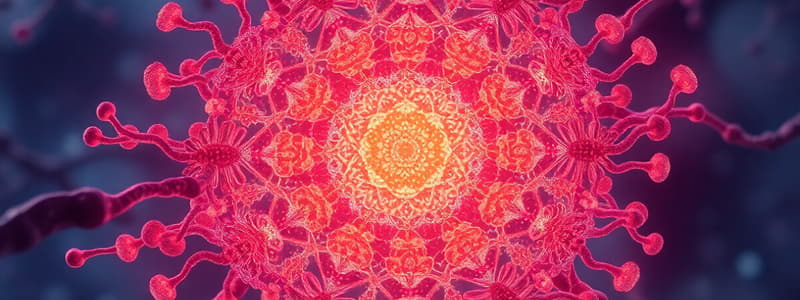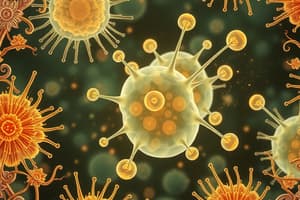Podcast
Questions and Answers
What is the primary structural feature of DNA in the nucleoid of prokaryotic cells?
What is the primary structural feature of DNA in the nucleoid of prokaryotic cells?
- Circular and typically not associated with histones (correct)
- Linear and associated with histones
- Linear and isolated within a nucleus
- Circular and enclosed by a membrane
Which factor is NOT involved in influencing the supercoiling levels of DNA in the nucleoid?
Which factor is NOT involved in influencing the supercoiling levels of DNA in the nucleoid?
- Transcription rates
- Concentration of porins (correct)
- ATP/ADP ratio
- Topoisomerase gene expression
How do plasmids contribute to bacterial diversity?
How do plasmids contribute to bacterial diversity?
- By facilitating horizontal gene transfer (correct)
- By producing energy through ATP synthesis
- By increasing the size of the nucleoid
- By integrating permanently into the genomic DNA
What is the primary evolutionary significance of mitochondria in eukaryotic cells?
What is the primary evolutionary significance of mitochondria in eukaryotic cells?
Which part of the mitochondrion is specifically involved in ATP production?
Which part of the mitochondrion is specifically involved in ATP production?
What role do Top1mt, Top3α, and Top2β play in mitochondria?
What role do Top1mt, Top3α, and Top2β play in mitochondria?
What distinguishes the membranes of mitochondria from the nucleoid structure in prokaryotes?
What distinguishes the membranes of mitochondria from the nucleoid structure in prokaryotes?
How does the arrangement of mtDNA in mitochondria differ from prokaryotic DNA?
How does the arrangement of mtDNA in mitochondria differ from prokaryotic DNA?
Flashcards are hidden until you start studying
Study Notes
Prokaryotic Nucleoid
- The nucleoid is a region in prokaryotic cells that contains DNA, RNA, and nucleoproteins.
- The nucleoid is not enclosed by a membrane.
- Prokaryotic DNA is typically circular and is not associated with histones.
- Most prokaryotes have one circular DNA molecule.
- Plasmids are small, circular DNA molecules that exist independently of the chromosomal DNA.
- Plasmids carry additional genetic information that can provide antibiotic resistance or the ability to metabolize unusual substances.
- Plasmids can transfer between bacteria through conjugation and can integrate into or exit the nucleoid.
- Supercoiling is a process that compacts and organizes the DNA in the nucleoid.
- DNA gyrase introduces negative supercoils, while DNA topoisomerase I prevents excessive supercoiling.
- The level of supercoiling in the nucleoid is influenced by factors such as topoisomerase gene expression, the ATP/ADP ratio, and transcription.
Mitochondrial DNA
- Mitochondria are thought to have originated from α-purple bacteria through an endosymbiotic event.
- Mitochondria transferred most of their essential genes to the nuclear genome over time and are now self-replicating organelles within the cell.
- Mitochondria have two membranes: an outer membrane and an inner membrane.
- The outer mitochondrial membrane is permeable to small molecules, ions, and ATP/ADP due to the presence of porins.
- The inner mitochondrial membrane is folded into cristae, which increase the surface area for ATP production.
- The inner mitochondrial membrane is selectively permeable and allows passage only to specific molecules, such as oxygen and ATP.
- The intermembrane space of the mitochondria has a composition similar to the cytosol.
- The mitochondrial matrix contains enzymes for ATP synthesis, mitochondrial ribosomes, tRNAs, and mtDNA.
- mtDNA is circular and negatively supercoiled, similar to bacterial DNA.
- mtDNA exists in multiple copies (4–10 per mitochondrion).
- Mitochondria have three topoisomerases: Top1mt, Top3α, and Top2β.
- All three mitochondrial topoisomerases are encoded in the nuclear genome.
Mitochondrial Functions
- Mitochondria replicate independently of the cell cycle.
- Mitochondria are inherited through the cytoplasm (cytoplasmic inheritance).
- Mitochondria produce ATP through aerobic respiration, which is 13 times more efficient than anaerobic pathways.
- Mitochondria play a crucial role in storing and regulating calcium ions.
- Mitochondria participate in the synthesis of steroid sex hormones.
- Mitochondria contain pro-apoptotic molecules that can trigger programmed cell death by activating cytosolic proteins.
Studying That Suits You
Use AI to generate personalized quizzes and flashcards to suit your learning preferences.




